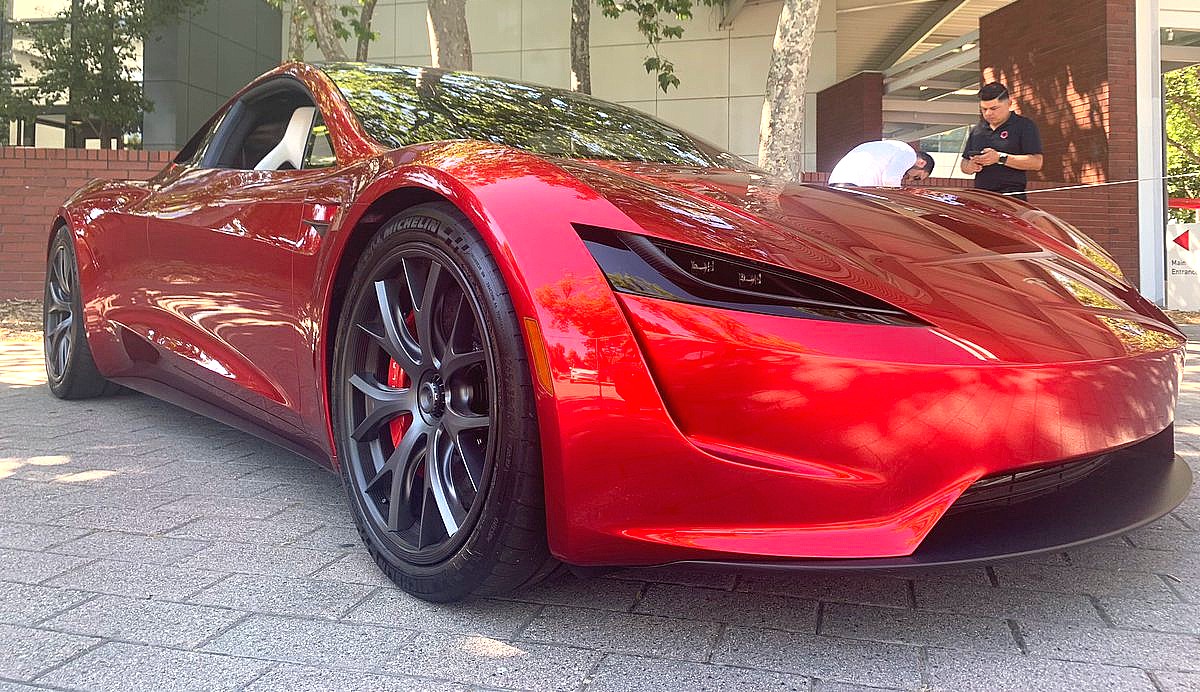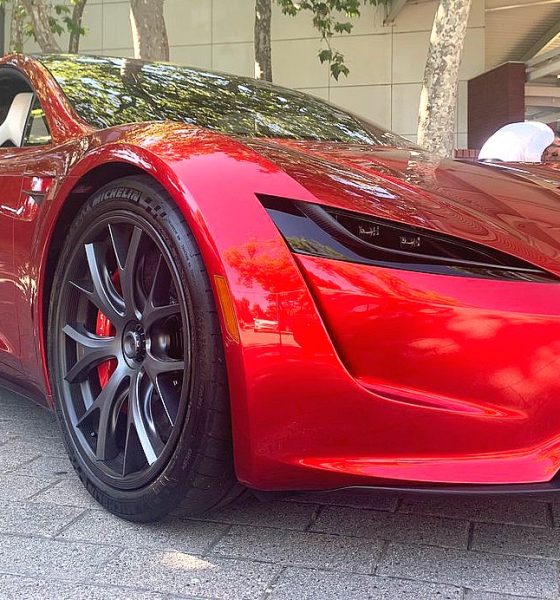

News
How Tesla’s new Roadster can benefit from Maxwell’s supercapacitors
The new Tesla Roadster is the very definition of a halo car. Embodying all the innovations that Tesla has developed and mastered over the years, the next-gen Roadster is intended, as Elon Musk put it, to give a “hardcore smackdown” to gasoline cars. During the CEO’s appearance at the Ride the Lightning podcast, Musk even candidly mentioned that the upcoming vehicle will have capabilities that are practically “unfair” to its internal combustion-powered competition.
It has been almost two years since the vehicle was unveiled, and over this time, Tesla has made headway in its electric vehicle tech. Earlier this year, Tesla completed the acquisition of Maxwell Technologies, a company that specializes in supercapacitors and the development of dry battery electrode technology. These innovations, which Tesla has complete access to, are a perfect fit for the next-generation Roadster.
Munro and Associates Sr. Associate Mark Ellis recently noted during an interview with Tesla owner-enthusiast Sean Mitchell that Maxwell’s tech have immense potential in the electric vehicle segment. “The dry battery technology is game-changing if it comes to pass and they can put it in a car,” he said. Ellis also explained that supercapacitor technology could greatly help electric vehicles in terms of their battery management.
“One of the issues with the battery is, when I step on the throttle hard, I’m pulling a lot of energy from the battery. And then, when I brake hard, I’m pulling a lot of energy out of the regen, but the batteries can’t take it fast enough. The batteries get really stressed when you try to pull it up too much, so if I had supercapacitors that I could use as a cushion; so when I need energy quickly, (I can) pull it from the supercapacitors and then fill the supercapacitors back up with the battery slowly; and then when I brake, I can capture more of that regen energy and do the supercapacitors faster. I think that just makes logical sense, because now all of a sudden I’ve got a sponge in front of my main energy source and I’m not stressing (the battery) so much,” he said.
This “sponge” that Ellis mentioned will be greatly beneficial for vehicles like the next-generation Roadster, which is designed to accelerate at incredibly rapid speeds. The Roadster will be insanely quick on a straight line with its 0-60 mph time of 1.9 seconds, and based on Musk’s previous statements about the vehicle, the all-electric supercar will be able to take on track driving as well. This means that the next-generation Roadster will be a monster of a supercar, and it will require serious refinement in terms of its battery and electric motors to maintain its optimum performance.
Tesla is a far more experienced carmaker today than it was when Elon Musk unveiled the next-generation Roadster in 2017. Considering that Tesla is a company with a culture of innovation, it is almost certain that the new Roadster, once it is released, will be a far more refined vehicle than the already-game-changing supercar that shocked the auto industry nearly two years ago. Elon Musk, if any, has mentioned some of these updates, one of which is a SpaceX package that will utilize cold gas thrusters (the same technology used in SpaceX’s Falcon 9 rockets) to help the vehicle’s acceleration, braking, and maneuverability.
The impending arrival of the next-generation Roadster appears to have started a disruption in the hypercar market. Since the vehicle’s unveiling, other carmakers have introduced all-electric monsters of their own. Among these is the ~$2.5 million, 1,900 hp Pininfarina Battista, the ~$2 million, 1,973 hp Lotus Evija, and the $2.1 million, 1,914 hp Rimac C_Two. Considering that the Roadster will start at around $200,000, the vehicle will likely be closer in price to upcoming premium sports EVs like the Taycan Turbo S, which is expected to command a notably higher price compared to the ~$130,000 Taycan Turbo.

News
Tesla FSD fleet is nearing 7 billion total miles, including 2.5 billion city miles
As can be seen on Tesla’s official FSD webpage, vehicles equipped with the system have now navigated over 6.99 billion miles.

Tesla’s Full Self-Driving (Supervised) fleet is closing in on almost 7 billion total miles driven, as per data posted by the company on its official FSD webpage.
These figures hint at the massive scale of data fueling Tesla’s rapid FSD improvements, which have been quite notable as of late.
FSD mileage milestones
As can be seen on Tesla’s official FSD webpage, vehicles equipped with the system have now navigated over 6.99 billion miles. Tesla owner and avid FSD tester Whole Mars Catalog also shared a screenshot indicating that from the nearly 7 billion miles traveled by the FSD fleet, more than 2.5 billion miles were driven inside cities.
City miles are particularly valuable for complex urban scenarios like unprotected turns, pedestrian interactions, and traffic lights. This is also the difference-maker for FSD, as only complex solutions, such as Waymo’s self-driving taxis, operate similarly on inner-city streets. And even then, incidents such as the San Francisco blackouts have proven challenging for sensor-rich vehicles like Waymos.
Tesla’s data edge
Tesla has a number of advantages in the autonomous vehicle sector, one of which is the size of its fleet and the number of vehicles training FSD on real-world roads. Tesla’s nearly 7 billion FSD miles then allow the company to roll out updates that make its vehicles behave like they are being driven by experienced drivers, even if they are operating on their own.
So notable are Tesla’s improvements to FSD that NVIDIA Director of Robotics Jim Fan, after experiencing FSD v14, noted that the system is the first AI that passes what he described as a “Physical Turing Test.”
“Despite knowing exactly how robot learning works, I still find it magical watching the steering wheel turn by itself. First it feels surreal, next it becomes routine. Then, like the smartphone, taking it away actively hurts. This is how humanity gets rewired and glued to god-like technologies,” Fan wrote in a post on X.
News
Tesla starts showing how FSD will change lives in Europe
Local officials tested the system on narrow country roads and were impressed by FSD’s smooth, human-like driving, with some calling the service a game-changer for everyday life in areas that are far from urban centers.

Tesla has launched Europe’s first public shuttle service using Full Self-Driving (Supervised) in the rural Eifelkreis Bitburg-Prüm region of Germany, demonstrating how the technology can restore independence and mobility for people who struggle with limited transport options.
Local officials tested the system on narrow country roads and were impressed by FSD’s smooth, human-like driving, with some calling the service a game-changer for everyday life in areas that are far from urban centers.
Officials see real impact on rural residents
Arzfeld Mayor Johannes Kuhl and District Administrator Andreas Kruppert personally tested the Tesla shuttle service. This allowed them to see just how well FSD navigated winding lanes and rural roads confidently. Kruppert said, “Autonomous driving sounds like science fiction to many, but we simply see here that it works totally well in rural regions too.” Kuhl, for his part, also noted that FSD “feels like a very experienced driver.”
The pilot complements the area’s “Citizen Bus” program, which provides on-demand rides for elderly residents who can no longer drive themselves. Tesla Europe shared a video of a demonstration of the service, highlighting how FSD gives people their freedom back, even in places where public transport is not as prevalent.
What the Ministry for Economic Affairs and Transport says
Rhineland-Palatinate’s Minister Daniela Schmitt supported the project, praising the collaboration that made this “first of its kind in Europe” possible. As per the ministry, the rural rollout for the service shows FSD’s potential beyond major cities, and it delivers tangible benefits like grocery runs, doctor visits, and social connections for isolated residents.
“Reliable and flexible mobility is especially vital in rural areas. With the launch of a shuttle service using self-driving vehicles (FSD supervised) by Tesla in the Eifelkreis Bitburg-Prüm, an innovative pilot project is now getting underway that complements local community bus services. It is the first project of its kind in Europe.
“The result is a real gain for rural mobility: greater accessibility, more flexibility and tangible benefits for everyday life. A strong signal for innovation, cooperation and future-oriented mobility beyond urban centers,” the ministry wrote in a LinkedIn post.
News
Tesla China quietly posts Robotaxi-related job listing
Tesla China is currently seeking a Low Voltage Electrical Engineer to work on circuit board design for the company’s autonomous vehicles.

Tesla has posted a new job listing in Shanghai explicitly tied to its Robotaxi program, fueling speculation that the company is preparing to launch its dedicated autonomous ride-hailing service in China.
As noted in the listing, Tesla China is currently seeking a Low Voltage Electrical Engineer to work on circuit board design for the company’s autonomous vehicles.
Robotaxi-specific role
The listing, which was shared on social media platform X by industry watcher @tslaming, suggested that Tesla China is looking to fill the role urgently. The job listing itself specifically mentions that the person hired for the role will be working on the Low Voltage Hardware team, which would design the circuit boards that would serve as the nervous system of the Robotaxi.
Key tasks for the role, as indicated in the job listing, include collaboration with PCB layout, firmware, mechanical, program management, and validation teams, among other responsibilities. The role is based in Shanghai.
China Robotaxi launch
China represents a massive potential market for robotaxis, with its dense urban centers and supportive policies in select cities. Tesla has limited permission to roll out FSD in the country, though despite this, its vehicles have been hailed as among the best in the market when it comes to autonomous features. So far, at least, it appears that China supports Tesla’s FSD and Robotaxi rollout.
This was hinted at in November, when Tesla brought the Cybercab to the 8th China International Import Expo (CIIE) in Shanghai, marking the first time that the autonomous two-seater was brought to the Asia-Pacific region. The vehicle, despite not having a release date in China, received a significant amount of interest among the event’s attendees.








